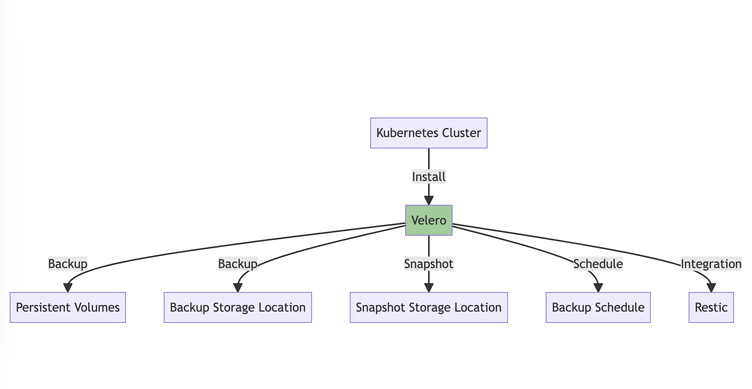For a Kubernetes-native backup architecture, use tools like Velero for efficient backup and restoration of Kubernetes resources and data. This architecture involves a backup tool, utilizing Persistent Volumes (PVs), specifying backup and snapshot storage locations (e.g., cloud storage services), implementing backup schedules, and potentially integrating with Restic for high-availability workloads. Velero captures snapshots of the cluster's state and PVs, storing them in the designated locations, enabling seamless restoration of resources and data when needed.
Designing a Kubernetes-native backup architecture involves creating a system that can efficiently back up and restore the state of your Kubernetes resources and data. Here's a high-level architecture suggestion:
Backup Tool: Use a Kubernetes-native backup tool like Velero (formerly known as Heptio Ark). Velero is a cloud-native disaster recovery and data migration tool for Kubernetes applications. It can back up your Kubernetes cluster's resources and data, and restore everything back to its state at the time of backup.
Persistent Volumes (PVs): Persistent Volumes provide storage for your Kubernetes applications. They can be backed up and restored with Velero.
Backup Storage Location: This is where your backups will be stored. It could be a cloud storage service like Amazon S3, Google Cloud Storage, or Azure Blob Storage. Velero supports multiple storage backends.
Snapshot Storage Location: This is where your Persistent Volume snapshots will be stored. It could also be a cloud storage service.
Backup Schedule: Velero supports creating backup schedules, which allows you to automate the backup process.
Restic Integration: For workloads with high-availability requirements, Velero integrates with Restic, an open-source tool for doing file-level backups.
Here's a high-level view of how these components might interact:
- Velero is installed on your Kubernetes cluster and configured with your chosen backup and snapshot storage locations.
- You create a backup schedule in Velero. When the schedule triggers, Velero takes a snapshot of your cluster's state and any specified Persistent Volumes.
- The backup and snapshots are stored in the configured storage locations.
- If you need to restore your cluster's state, Velero can use the stored backup and snapshots to restore your Kubernetes resources and data.


